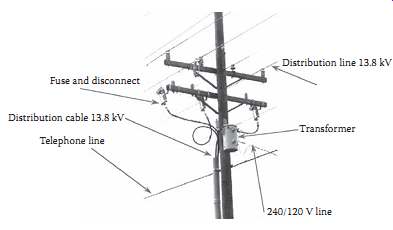AMAZON multi-meters discounts AMAZON oscilloscope discounts
.
OVERVIEW:
1. Generation Stations
2. Switchgear
3. Control Devices
4. Concept of Energy Transmission and Distribution: High-Voltage Transmission Lines • High-Voltage DC Lines • Subtransmission Lines • Distribution Lines
The purpose of the electric transmission system is the interconnection of the electric-energy-producing power plants or generating stations with the loads. A three-phase AC system is used for most transmission lines. The operating frequency is 60 Hz in the United States and 50 Hz in Europe, Australia, and part of Asia. The three-phase system has three phase conductors. The system voltage is defined as the rms voltage between the conductors, also called line-to-line voltage. The voltage between the phase conductor and ground, called line-to-ground voltage, is equal to the line-to-line voltage divided by the square root of three. Fig. 1 shows a typical system.
The figure shows the Phoenix area 230 kV system, which interconnects the local power plants and the substations supplying different areas of the city. The circles are the substations and the squares are the generating stations. The system contains loops that assure that each load substation is supplied by at least two lines. This assures that the outage of a single line does not cause loss of power to any customer.
For example, the Aqua Fria generating station (marked: power plant) has three outgoing lines. Three high-voltage cables supply the Country Club Substation (marked: substation with cables). The Pinnacle Peak Substation (marked: substation with transmission lines) is a terminal for six transmission lines.
This example shows that the substations are the node points of the electric system. The system is interconnected with the neighboring systems. As an example, one line goes to Glen Canyon and the other to Cholla from the Pinnacle Peak substation.
In the middle of the system, which is in a congested urban area, high-voltage cables are used. In open areas, overhead transmission lines are used. The cost per mile of overhead transmission lines is 6%-10% less than underground cables. The major components of the electric system, the transmission lines, and cables are described briefly later [1].
===

Above: Fig. 1 One line diagram of a high-voltage electric transmission system.
Legend: 230 kV substation EHV lines 230 kV lines overhead Underground Generating site and 230 kV substation Joint ownership other companies' lines
===
1 Generation Stations
The generating station converts the stored energy of gas, oil, coal, nuclear fuel, or water position to electric energy. The most frequently used power plants are as follows:
Thermal power plant. The fuel is pulverized coal or natural gas. Older plants may use oil. The fuel is mixed with air and burned in a boiler that generates steam. The high-pressure and high temperature steam drives the turbine, which turns the generator that converts the mechanical energy to electric energy.
Nuclear power plant. Enriched uranium produces atomic fission that heats water and produces steam. The steam drives the turbine and generator.
Hydro power plants. A dam increases the water level on a river, which produces fast water flow to drive a hydro-turbine. The hydro-turbine drives a generator that produces electric energy.
Gas turbine. Natural gas is mixed with air and burned. This generates a high-speed gas flow that drives the turbine, which turns the generator.
Combined cycle power plant. This plant contains a gas turbine that generates electricity. The exhaust from the gas turbine is high-temperature gas. The gas supplies a heat exchanger to preheat the combustion air to the boiler of a thermal power plant. This process increases the efficiency of the combined cycle power plant. The steam drives a second turbine, which drives the second generator. This two-stage operation increases the efficiency of the plant.
===
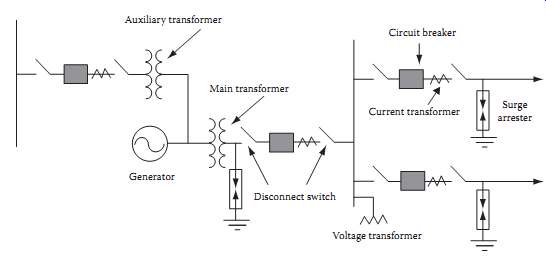
Above: Fig. 2 Simplified connection diagram of a generating station.
Auxiliary transformer Main transformer Generator Disconnect switch Current transformer Circuit breaker Surge arrester Voltage transformer
===
2 Switchgear
The safe operation of the system requires switches to open lines automatically in case of a fault, or manually when the operation requires it. Fig. 2 shows the simplified connection diagram of a generating station.
The generator is connected directly to the low-voltage winding of the main transformer. The transformer high-voltage winding is connected to the bus through a circuit breaker (CB), disconnect switch, and current transformer (CT). The generating station auxiliary power is supplied through an auxiliary transformer through a CB, disconnect switch, and CT. Generator CBs, connected between the generator and transformer, are frequently used in Europe. These breakers have to interrupt the very large short circuit current of the generators, which results in high cost.
The high-voltage bus supplies two outgoing lines. The station is protected from lightning and switching surges by a surge arrester.
Circuit breaker (CB) is a large switch that interrupts the load and fault current. Fault detection systems automatically open the CB, but it can be operated manually.
Disconnect switch provides visible circuit separation and permits CB maintenance. It can be operated only when the CB is open, in no-load condition.
Potential transformers (PTs) and CTs reduce the voltage to 120 V and the current to 5 A and insulate the low-voltage circuit from the high voltage. These quantities are used for metering and protective relays. The relays operate the appropriate CB in case of a fault.
Surge arresters are used for protection against lightning and switching overvoltages. They are voltage dependent, nonlinear resistors.
3 Control Devices
In an electric system, the voltage and current can be controlled. The voltage control uses parallel connected devices, while the f low or current control requires devices connected in series with the lines.
Tap-changing transformers are frequently used to control the voltage. In this system, the turns-ratio of the transformer is regulated, which controls the voltage on the secondary side. The ordinary tap changer uses a mechanical switch. A thyristor-controlled tap changer has recently been introduced.
A shunt capacitor connected in parallel with the system through a switch is the most frequently used voltage control method. The capacitor reduces lagging-power-factor reactive power and improves the power factor. This increases voltage and reduces current and losses. Mechanical and thyristor switches are used to insert or remove the capacitor banks.
The frequently used static var compensator (SVC) consists of a switched capacitor bank and a thyristor controlled inductance. This permits continuous regulation of reactive power.
The current of a line can be controlled by a capacitor connected in series with the line. The capacitor reduces the inductance between the sending and receiving points of the line. The lower inductance increases the line current if a parallel path is available.
In recent years, electronically controlled series compensators have been installed in a few transmission lines. This compensator is connected in series with the line, and consists of several thyristor- controlled capacitors in series or parallel, and may include thyristor-controlled inductors. Medium- and low-voltage systems use several other electronic control devices. The last part in this section gives an outline of the electronic control of the system.
4 Concept of Energy Transmission and Distribution
Fig. 3 shows the concept of typical energy transmission and distribution systems. The generating station produces the electric energy. The generator voltage is around 15-25 kV. This relatively low volt age is not appropriate for the transmission of energy over long distances. At the generating station, a transformer is used to increase the voltage and reduce the current. In Fig. 3, the voltage is increased to 500 kV and an extra-high-voltage (EHV) line transmits the generator-produced energy to a distant substation. Such substations are located on the outskirts of large cities or in the center of several large loads. As an example, in Arizona, a 500 kV transmission line connects the Palo Verde Nuclear Station to the Kyrene and Westwing substations, which supply a large part of the city of Phoenix.
The voltage is reduced at the 500/220 kV EHV substation to the high-voltage level and high-voltage lines transmit the energy to high-voltage substations located within cities.
At the high-voltage substation, the voltage is reduced to 69 kV. Subtransmission lines connect the high-voltage substation to many local distribution stations located within cities. Subtransmission lines are frequently located along major streets [2,3].
The voltage is reduced to 12 kV at the distribution substation. Several distribution lines emanate from each distribution substation as overhead or underground lines. Distribution lines distribute the energy along streets and alleys. Each line supplies several step-down transformers distributed along the line.
The distribution transformer reduces the voltage to 230/115 V, which supplies houses, shopping centers, and other local loads. The large industrial plants and factories are supplied directly by a subtransmission line or a dedicated distribution line as shown in Fig. 3.
The overhead transmission lines are used in open areas such as interconnections between cities or along wide roads within the city. In congested areas within cities, underground cables are used for electric energy transmission. The underground transmission system is environmentally preferable but has a significantly higher cost. In Fig. 3 the 12 kV line is connected to a 12 kV cable, which supplies commercial or industrial customers [4]. The figure also shows 12 kV cable networks supplying down town areas in a large city. Most newly developed residential areas are supplied by 12 kV cables through pad-mounted step-down transformers as shown in Fig. 3.
===
Power plant 12 kV commercial or industrial customer Downtown network 69/12 kV substation 69 kV subtransmission 230/69 kV substation To 230 kV substation 12 kV distribution Overhead 12 kV distribution transformer Residential customer Underground 12 kV distribution transformer Residential customer 12 kV distribution 500 kV transmission To 230 kV substation 500/230 kV substation Transmission 230 kV transmission Generation Distribution

Above: Fig. 3 Concept of electric energy transmission.
===
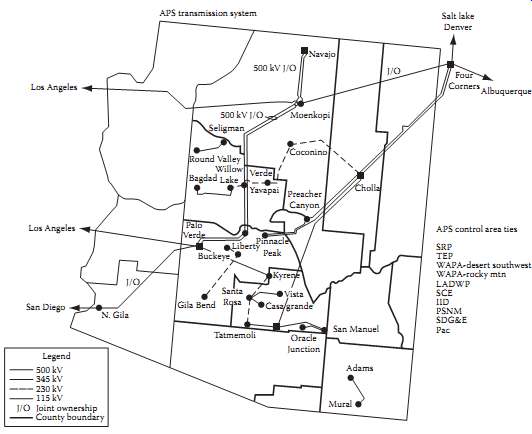
Above: Fig. 4 Typical high-voltage and EHV transmission system
===
129?-3/4? 44? 7? 131? 0? Shield conductor Insulator Tower Grounding electrodes Foundation Bundle conductor (4 conductors)
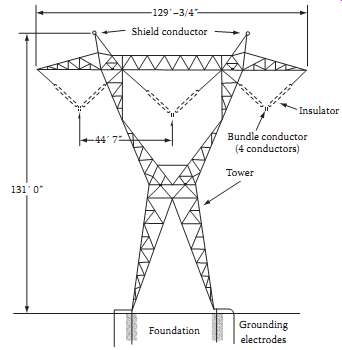
Above: Fig. 5 Typical high-voltage transmission line.
===
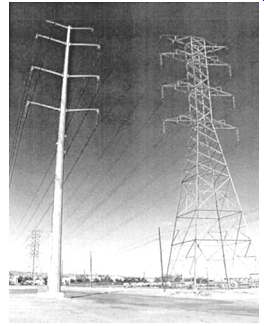
Above: Fig. 6 Typical 230 kV constructions.
===
4.1 High-Voltage Transmission Lines
High-voltage and extra-high-voltage (EHV) transmission lines interconnect power plants and loads, and form an electric network. Fig. 4 shows a typical high-voltage and EHV system.
This system contains 500, 345, 230, and 115 kV lines. The figure also shows that the Arizona (AZ) system is interconnected with transmission systems in California, Utah, and New Mexico. These inter connections provide instantaneous help in case of lost generation in the AZ system. This also permits the export or import of energy, depending on the needs of the areas.
Presently, synchronous ties (AC lines) interconnect all networks in the eastern United States and Canada. Synchronous ties also (AC lines) interconnect all networks in the western United States and Canada. Several nonsynchronous ties (DC lines) connect the East and the West. These interconnections increase the reliability of the electric supply systems.
In the United States, the nominal voltage of the high-voltage lines is between 100 and 230 kV. The voltage of the EHV lines is above 230 kV and below 800 kV. The voltage of an ultrahigh-voltage line is above 800 kV. The maximum length of high-voltage lines is around 200 miles. EHV transmission lines generally supply energy up to 400-500 miles without intermediate switching and var support.
Transmission lines are terminated at the bus of a substation.
The physical arrangement of most EHV lines is similar. Fig. 5 shows the major components of an EHV, which are as follows:
1. Tower: The figure shows a lattice, steel tower.
2. Insulator: V strings hold four bundled conductors in each phase.
3. Conductor: Each conductor is a stranded, steel-reinforced aluminum cable.
4. Foundation and grounding: Steel-reinforced concrete foundation and grounding electrodes placed in the ground.
5. Shield conductors: Two grounded shield conductors protect the phase conductors from lightning.
At lower voltages, the appearance of lines can be improved by using more aesthetically pleasing steel tubular towers. Steel tubular towers are made out of a tapered steel tube equipped with banded arms.
The arms hold the insulators and the conductors. Fig. 6 shows typical 230 kV steel tubular and lattice double-circuit towers. Both lines carry two three-phase circuits and are built with two conductor bundles to reduce corona and radio and TV noise. Grounded shield conductors protect the phase conductors from lightning [1].
4.2 High-Voltage DC Lines
High-voltage DC lines are used to transmit large amounts of energy over long distances or through waterways. One of the best known is the Pacific HVDC Intertie, which interconnects southern California with Oregon. Another DC system is the ±400 kV Coal Creek-Dickenson lines. Another famous HVDC system is the interconnection between England and France, which uses underwater cables. In Canada, Vancouver Island is supplied through a DC cable.
In an HVDC system, the AC voltage is rectified and a DC line transmits the energy. At the end of the line, an inverter converts the DC voltage to AC. A typical example is the Pacific HVDC Intertie that operates with ±500 kV voltage and interconnects Southern California with the hydro stations in Oregon.
Fig. 7 shows a guyed tower arrangement used on the Pacific HVDC Intertie. Four guy wires balance the lattice tower. The tower carries a pair of two-conductor bundles supported by suspension insulators.
==
Insulator Bundled conductors Guyed wire

Above: Fig. 7 HVDC tower arrangement.
==

Above: Fig. 8 Subtransmission system.

Above: Fig. 9 Typical subtransmission line.
===
4.3 Subtransmission Lines
Typical subtransmission lines interconnect the high-voltage substations with distribution stations within a city. The voltage of the subtransmission system is between 46, 69, and 115 kV. The maximum length of sub-transmission lines is in the range of 50-60 miles. Most subtransmission lines are located along streets and alleys. Fig. 8 shows a typical subtransmission system.
This system operates in a looped mode to enhance continuity of service. This arrangement assures that the failure of a line won’t interrupt the customer's power.
Fig. 9 shows a typical double-circuit subtransmission line, with a wooden pole and post-type insulators. Steel tube or concrete towers are also used. The line has a single conductor in each phase.
Post-insulators hold the conductors without metal cross arms. One grounded shield conductor on the top of the tower shields the phase conductors from lightning. The shield conductor is grounded at each tower. Plate or vertical tube electrodes (ground rod) are used for grounding.
===
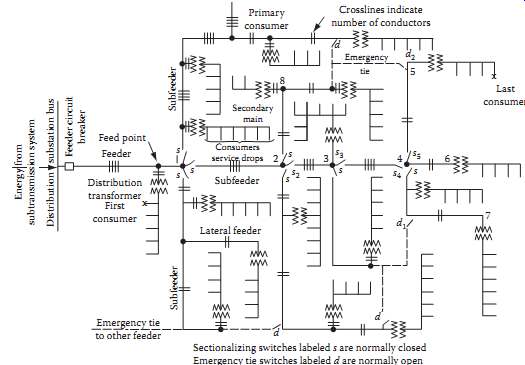
Above: Fig. 10 Concept of radial distribution system.
Sectionalizing switches labeled s are normally closed
Emergency tie switches labeled d are normally open
Primary consumer
Crosslines indicate number of conductors
Emergency tie to other feeder
Distribution transformer
First consumer
Feeder circuit breaker substation bus
Distribution
Energy from subtransmission system
===
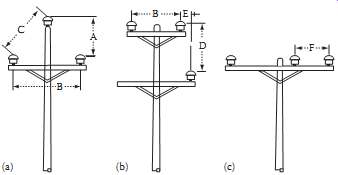
Above: Fig. 11 Distribution line arrangements: (a) pole top, (b) two arm,
and (c) single arm.
===
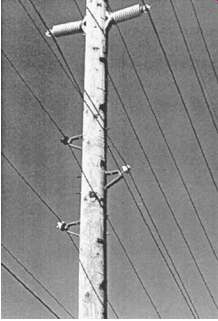
Above: Fig. 12 Distribution line installed under the subtransmission line.
Fuse and disconnect Distribution line 13.8 kV Transformer 240/120 V line Distribution cable 13.8 kV Telephone line
===
===
4.4 Distribution Lines
The distribution system is a radial system. Fig. 10 shows the concept of a typical urban distribution system. In this system, a main three-phase feeder goes through the main street. Single-phase subfeeders supply the crossroads. Secondary mains are supplied through transformers. The consumer's ser vice drops supply the individual loads. The voltage of the distribution system is between 4.6 and 25 kV. Distribution feeders can supply loads up to 20-30 miles.
Many distribution lines in the United States have been built with a wood pole and cross arm. The wood is treated with an injection of creosote or other wood preservative that protects the wood from rotting and termites. Most poles are buried in a hole without foundation. Lines built recently may use a simple concrete block foundation. Small porcelain or non-ceramic, pin-type insulators support the conductors. The insulator pin is grounded to eliminate leakage current, which can cause burning of the wood tower. A simple vertical copper rod is used for grounding. Shield conductors are seldom used.
Fig. 11 shows typical distribution line arrangements.
Because of the lack of space in urban areas, distribution lines are often installed on the subtransmission line towers. This is referred to as underbuild. A typical arrangement is shown in Fig. 12.
The figure shows that small porcelain insulators support the conductors. The insulators are installed on metal brackets that are bolted onto the wood tower. This arrangement reduces the right-of-way requirement and saves space.
Transformers mounted on distribution poles frequently supply individual houses or groups of houses.
Fig. 13 shows a typical transformer pole, consisting of a transformer that supplies a 240/120 V ser vice drop, and a 13.8 kV distribution cable. The latter supplies a nearby shopping center, located on the other side of the road. The 13.8 kV cable is protected by a cut-off switch that contains a fuse mounted on a pivoted insulator. The lineman can disconnect the cable by pulling the cut-off open with a long insulated rod (hot stick).
